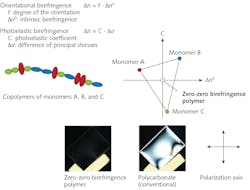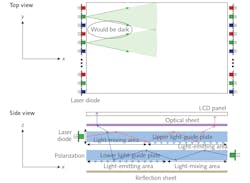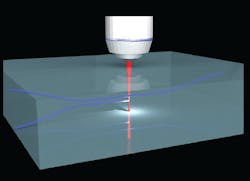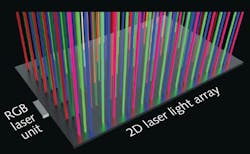Laser backlights have advantages for liquid-crystal displays
Liquid-crystal displays (LCDs) use a backlight to create light, which is then modulated by the LCD panel. Today, almost all LCDs use LEDs as the backlight source, but development is underway to use lasers instead. Their use could lead to big improvements in color performance and power efficiency.
At the recent Society for Information Display (SID)-organized DisplayWeek conference (June 7-12, 2020), two companies presented papers on their laser-backlight development efforts. The idea of using lasers in a backlight is not new. Previous designs have typically used the laser to fill the backlight using total internal reflection and extraction structures to homogenize the light and extract it toward the LCD panel, just as conventional LED-based backlight units do.
One problem with this approach is that this destroys the polarization of the light so there is no power-efficiency advantage. That’s because in an LCD display, the LCD panel is sandwiched between two polarizers. All backlights produce unpolarized light, so there is an immediate 50% loss of light going through the first polarizer—a big hit in power efficiency. A polarization-reflective polarizer coupled with a reflective backlight has been developed, but this may add at most 10–15% additional light throughput. The goal is to create a polarized laser-based backlight that eliminates the need for the prepolarizer, offering a dramatic increase in power efficiency.
The second clear advantage of a laser backlight is the wider color gamut it can enable. The color gamut standard for 4K and 8K content is the BT.2020 gamut. However, this gamut is so large that no commercial flat-panel displays can achieve this yet. As a result, 4K and 8K content is mastered in the smaller DCI-P3 color gamut—the same one used for theatrical screens. Reaching the full BT.2020 gamut essentially requires the use of laser light sources, as the specified RGB primaries are on the spectral locus, meaning that they are single-wavelength primaries. The full width half maximum (FWHM) spectral band of red, green, and blue (RGB) LEDs and even quantum dots are tens of nanometers, which is too broad to reach the full BT.2020 gamut. RGB lasers with single-nanometer FWHM profiles have the potential to enable this color gamut.
In addition, the use of lasers may allow elimination of the color filters, reducing costs and further increasing efficiency without sacrificing color performance.
Shinichi Komura from Japan Display (Tokyo, Japan) described the company’s second-generation laser backlight display, noting that what is new in the second generation is what is called a zero-zero birefringent polymer light-guide plate (see Fig. 1). The light-guide plate is where light from the input LEDs or lasers is mixed and homogenized. Typical polymer-based light-guide plates are not uniform in birefringence, leading to a spatial variation in the polarization when polarized light sources are used. The clever solution Japan Display came up with was to design a hybrid polymer solution composed of three different monomers with different values of the photoelectric coefficient and differential intrinsic birefringence. The result was a composite material that zeroed out these two parameters, leading to a highly spatially uniform polarization state across the backlight.
The second innovation developed by Japan Display was a dual-light-guide plate backlight architecture (see Fig. 2). In a single light-guide plate, LEDs or lasers mounted on the side need a certain distance for the light to mix before they are directed toward the LCD and extracted. For the lasers chosen by Japan Display, this mixing area was quite large, which would result in very spatially nonuniform white light. A second light-guide plate was therefore mounted below the first one with the laser diodes placed on the opposite side to balance the uniformity of the emitted light.Finally, Japan Display constructed a 17.3 in. 8K resolution display using the new zero-zero backlight. Compared to the first-generation version of this display, which has a conventional light-guide plate, luminance was increased from 435 cd/m2 to 1090 cd/m2 while maintaining the same 98% coverage of the BT.2020 color gamut.
Vienna-based VitreaLab described a different approach to achieving an RGB laser light display, which could even be adapted to illuminate a spatial light modulator (SLM) to create a holographic display down the road.
Cofounders Jonas Zeuner and Chiara Greganti explained that they use a special laser writing technique in a glass-based light-guide plate. This technique allows them to create millions of tiny (a few microns) single-mode waveguide elements to direct laser light to each and every subpixel in the display. A tiny mirror is also placed below each subpixel to extract the light and aim it toward the LCD panel.
VitreaLab believes that with its approach one can eliminate the polarizers and color filters from the LCD. This gives designers the choice to reduce power consumption by around 80% or to produce a display with 5X more luminance—or to choose something in between these two endpoints. By choosing the wavelengths correctly, one should be able to achieve >95% of the BT.2020 color gamut coverage. And finally, since the laser light should emerge with much more collimation, this should reduce crosstalk and increase the native contrast of an LCD panel.
So far, the team has demonstrated small-scale prototype arrays showing that the concept works and produces RGB light (see Fig. 3). Over the next year, they plan to develop a more comprehensive developer kit with a prototype that potential customers can use to better evaluate for their application. They will also need to work on improving efficiency and prove out mass-production capabilities.A single bank of RGB laser diodes can be used to power phone-sized displays, with additional lasers needed for larger screen sizes. Such lasers should be available for around $1 each in high-volume production, Zeuner and Greganti estimate. Local dimming may be possible as well, depending on how the laser beams are routed from the laser banks.
It may also be possible to use this type of backlight to create larger-sized true holographic displays. Today’s holographic displays are mostly created using laser light and spatial light modulators, which are specially formulated liquid-crystal-on-silicon (LCOS) microdisplays. The new laser backlight opens the potential to use a standard LCD panel and to write a phase hologram to the panel instead of a raster-based image. This concept will require a lot of development work, but is a very intriguing possibility.
Chris Chinnock
Chris Chinnock is president and owner of Insight Media in Norwalk, CT. He is a 30-year display industry veteran with experiences in displays, broadcast, cinema, ProAV, and consumer electronics.




